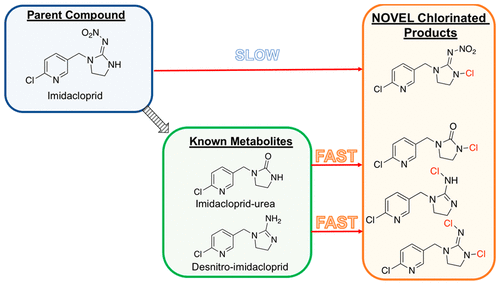当前位置:
X-MOL 学术
›
Environ. Sci. Technol. Lett.
›
论文详情
Our official English website, www.x-mol.net, welcomes your
feedback! (Note: you will need to create a separate account there.)
Chlorinated Byproducts of Neonicotinoids and Their Metabolites: An Unrecognized Human Exposure Potential?
Environmental Science & Technology Letters ( IF 8.9 ) Pub Date : 2019-01-22 , DOI: 10.1021/acs.estlett.8b00706 Kathryn L. Klarich Wong 1, 2 , Danielle T. Webb 1, 2 , Matthew R. Nagorzanski 1, 2 , Dana W. Kolpin 3 , Michelle L. Hladik 4 , David M. Cwiertny 1, 2, 5, 6 , Gregory H. LeFevre 1, 2
Environmental Science & Technology Letters ( IF 8.9 ) Pub Date : 2019-01-22 , DOI: 10.1021/acs.estlett.8b00706 Kathryn L. Klarich Wong 1, 2 , Danielle T. Webb 1, 2 , Matthew R. Nagorzanski 1, 2 , Dana W. Kolpin 3 , Michelle L. Hladik 4 , David M. Cwiertny 1, 2, 5, 6 , Gregory H. LeFevre 1, 2
Affiliation

|
We recently reported the initial discovery of neonicotinoid pesticides in drinking water and their potential for transformation through chlorination and alkaline hydrolysis during water treatment. The objectives of this research were: (1) to determine if neonicotinoid metabolites are relevant to drinking water exposure and (2) to identify the products formed from chlorination of neonicotinoids and their metabolites. Desnitro-imidacloprid and imidacloprid-urea, two known metabolites of imidacloprid, are documented for the first time in drinking water. Desnitro-imidacloprid was present above the lower level of detection (0.03 ng/L) in 67% of samples (six of nine) from drinking water systems but detectable in all samples (up to 0.6 ng/L). Although concentrations of desnitro-imidacloprid were lower than concentrations of the parent neonicotinoids, desnitro-imidacloprid exhibits significantly greater mammalian toxicity than imidacloprid. Using LC-HR-ToF-MS/MS analysis of results from laboratory experiments, we propose structures for novel transformation products resulting from the chlorination of clothianidin, imidacloprid, desnitro-imidacloprid, imidacloprid-urea, and hydrolysis products of thiamethoxam. Formation of chlorinated neonicotinoid byproducts occurs at time scales relevant to water treatment and/or distribution for the imidacloprid metabolites (t1/2 values from 2.4 min to 1.0 h) and thiamethoxam hydrolysis products (4.8 h). Neonicotinoid metabolites in finished drinking water and potential formation of novel disinfection byproducts during treatment and/or distribution are relevant to evaluating the exposure and potential impacts of neonicotinoids on human health.
中文翻译:

新烟碱类及其代谢产物的氯化副产物:人类无法识别的暴露潜能?
我们最近报道了饮用水中新烟碱类农药的最初发现及其在水处理过程中通过氯化和碱水解而转化的潜力。这项研究的目的是:(1)确定新烟碱代谢物是否与饮用水接触有关;(2)鉴定新烟碱及其代谢物经氯化形成的产物。饮用水中首次记载了吡虫啉的两种已知代谢产物去硝基吡虫啉和吡虫啉-尿素。在饮用水系统的67%的样品(九个中的六个)中,去硝基吡虫啉的检出水平较低(0.03 ng / L),但在所有样品中均可检出(最高0.6 ng / L)。尽管去硝基吡虫啉的浓度低于母体新烟碱的浓度,与吡虫啉相比,去硝基吡虫啉显示出更大的哺乳动物毒性。使用实验室实验结果的LC-HR-ToF-MS / MS分析,我们提出了由可比丁,吡虫啉,去硝基-吡虫啉,吡虫啉-脲和噻虫嗪的水解产物氯化生成的新型转化产物的结构。氯化新烟碱类副产物的形成发生在与水处理和/或吡虫啉代谢物分布相关的时间尺度上(和噻虫嗪的水解产物。氯化新烟碱类副产物的形成发生在与水处理和/或吡虫啉代谢物分布相关的时间尺度上(和噻虫嗪的水解产物。氯化新烟碱类副产物的形成发生在与水处理和/或吡虫啉代谢物分布相关的时间尺度上(t 1/2值从2.4分钟到1.0小时)和噻虫嗪水解产物(4.8小时)。成品饮用水中的新烟碱代谢产物以及在治疗和/或分配过程中可能形成新的消毒副产物,与评估新烟碱对人体健康的暴露及其潜在影响有关。
更新日期:2019-02-07
中文翻译:

新烟碱类及其代谢产物的氯化副产物:人类无法识别的暴露潜能?
我们最近报道了饮用水中新烟碱类农药的最初发现及其在水处理过程中通过氯化和碱水解而转化的潜力。这项研究的目的是:(1)确定新烟碱代谢物是否与饮用水接触有关;(2)鉴定新烟碱及其代谢物经氯化形成的产物。饮用水中首次记载了吡虫啉的两种已知代谢产物去硝基吡虫啉和吡虫啉-尿素。在饮用水系统的67%的样品(九个中的六个)中,去硝基吡虫啉的检出水平较低(0.03 ng / L),但在所有样品中均可检出(最高0.6 ng / L)。尽管去硝基吡虫啉的浓度低于母体新烟碱的浓度,与吡虫啉相比,去硝基吡虫啉显示出更大的哺乳动物毒性。使用实验室实验结果的LC-HR-ToF-MS / MS分析,我们提出了由可比丁,吡虫啉,去硝基-吡虫啉,吡虫啉-脲和噻虫嗪的水解产物氯化生成的新型转化产物的结构。氯化新烟碱类副产物的形成发生在与水处理和/或吡虫啉代谢物分布相关的时间尺度上(和噻虫嗪的水解产物。氯化新烟碱类副产物的形成发生在与水处理和/或吡虫啉代谢物分布相关的时间尺度上(和噻虫嗪的水解产物。氯化新烟碱类副产物的形成发生在与水处理和/或吡虫啉代谢物分布相关的时间尺度上(t 1/2值从2.4分钟到1.0小时)和噻虫嗪水解产物(4.8小时)。成品饮用水中的新烟碱代谢产物以及在治疗和/或分配过程中可能形成新的消毒副产物,与评估新烟碱对人体健康的暴露及其潜在影响有关。











































 京公网安备 11010802027423号
京公网安备 11010802027423号